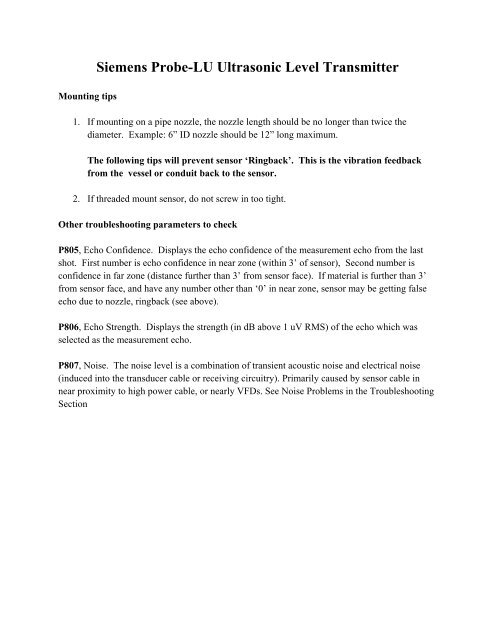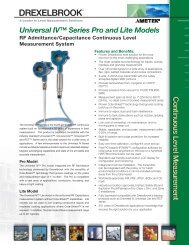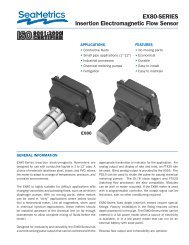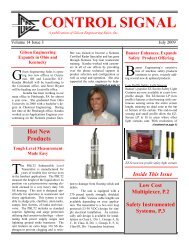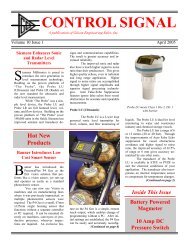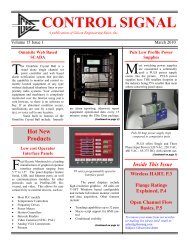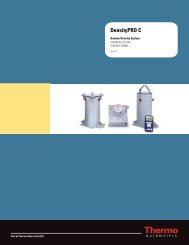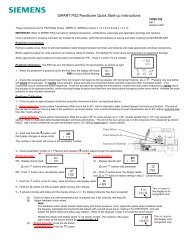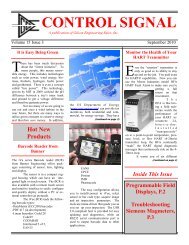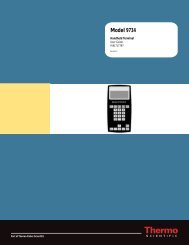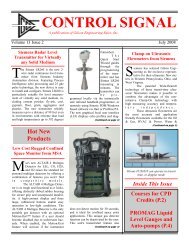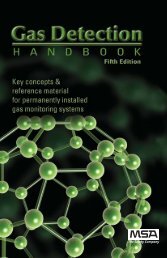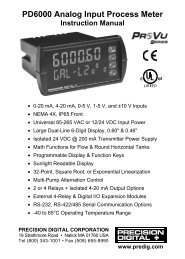Siemens Probe-LU Ultrasonic Level Transmitter
Siemens Probe-LU Ultrasonic Level Transmitter
Siemens Probe-LU Ultrasonic Level Transmitter
You also want an ePaper? Increase the reach of your titles
YUMPU automatically turns print PDFs into web optimized ePapers that Google loves.
Mounting tips<br />
<strong>Siemens</strong> <strong>Probe</strong>-<strong>LU</strong> <strong>Ultrasonic</strong> <strong>Level</strong> <strong>Transmitter</strong><br />
1. If mounting on a pipe nozzle, the nozzle length should be no longer than twice the<br />
diameter. Example: 6” ID nozzle should be 12” long maximum.<br />
The following tips will prevent sensor ‘Ringback’. This is the vibration feedback<br />
from the vessel or conduit back to the sensor.<br />
2. If threaded mount sensor, do not screw in too tight.<br />
Other troubleshooting parameters to check<br />
P805, Echo Confidence. Displays the echo confidence of the measurement echo from the last<br />
shot. First number is echo confidence in near zone (within 3’ of sensor), Second number is<br />
confidence in far zone (distance further than 3’ from sensor face). If material is further than 3’<br />
from sensor face, and have any number other than ‘0’ in near zone, sensor may be getting false<br />
echo due to nozzle, ringback (see above).<br />
P806, Echo Strength. Displays the strength (in dB above 1 uV RMS) of the echo which was<br />
selected as the measurement echo.<br />
P807, Noise. The noise level is a combination of transient acoustic noise and electrical noise<br />
(induced into the transducer cable or receiving circuitry). Primarily caused by sensor cable in<br />
near proximity to high power cable, or nearly VFDs. See Noise Problems in the Troubleshooting<br />
Section
Common Problems Chart<br />
Note: Many of the parameters and techniques described here require extensive knowledge of ultrasonic<br />
technologies and <strong>Siemens</strong> echo processing software. Use this information with caution.<br />
Sym<br />
Symptom Cause Action<br />
Display blank, transducer<br />
not pulsing.<br />
No response to programmer.<br />
No power.<br />
Obstructed infrared interface,<br />
defective programmer.<br />
Check power supply, wiring, or<br />
power fuse.<br />
Check programmer usage:<br />
15 cm (6”) from faceplate<br />
pointed at upper target.<br />
Displays LOE. Weak or non-existent echo. Relocate and/or re-aim transducer<br />
at material.<br />
Proceed to Measurement difficulties.<br />
Reading is fixed, regardless of the<br />
actual material level.<br />
Material level reported is always<br />
incorrect by the same amount.<br />
Reading is erratic, with little or no<br />
relation to material level.<br />
Transducer acoustic beam<br />
obstructed, standpipe too narrow,<br />
or transducer ringing (reads over<br />
100%).<br />
Incorrect Empty (zero) reference<br />
for level operation (P001= 1).<br />
True echo too weak or wrong echo<br />
being processed.<br />
Relocate and / or re-aim transducer<br />
at material level or object.<br />
Proceed to Measurement Difficulties<br />
below. See also: Transducer ringing.<br />
See Empty (P006), Reading Offset<br />
(P063), Offset Calibration (P650), &<br />
Offset Correction (P652).<br />
Relocate and / or re-aim transducer<br />
at material.<br />
Check noise parameters. See Noise<br />
Problems.


